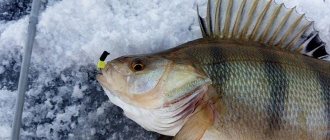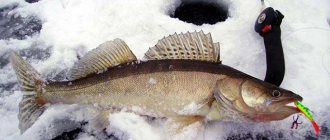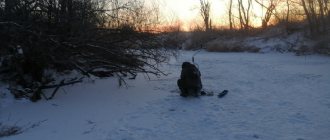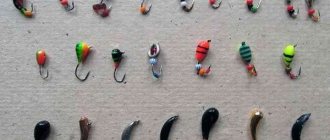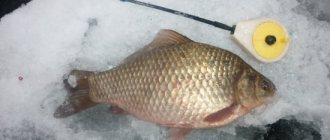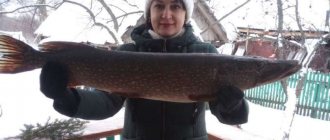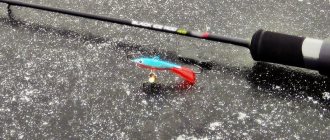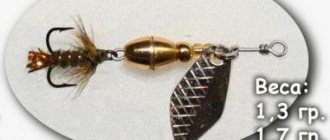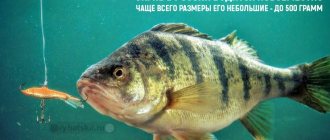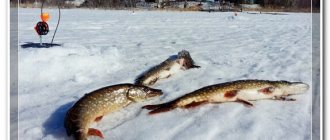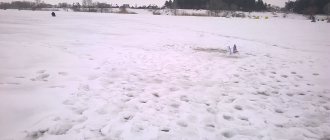What kind of fish is caught on the first ice?
The first ice brings fishing on the first ice. It begins with the onset of cold weather on frozen bodies of water. Fishing is rarely unsuccessful. Before wintering, the fish have become hungry and greedily grab any bait. This period lasts approximately two weeks. At this time, in different regions of the country, you can catch the following fish with different gear:
- bleak;
- white bream;
- zander;
- roach;
- perch;
- gudgeon;
- trout;
- pike;
- bream;
- silver bream;
- ruff;
- burbot;
- taimen fish;
- chub;
- grayling.
A successful fisherman can catch both small bleak and large taimen, reaching a weight of 60 kg.
How to catch a large perch on the first ice
So - to consolidate, catching perch on the first ice is always active, regardless of the use of different types of gear. The tactics are almost the same everywhere:
- We drill from five to twenty holes according to a special pattern, starting from the shore of the reservoir.
- We use complementary foods, any of the convenient options that we discussed earlier.
- We check the holes with gear.
- When the bite comes, we continue fishing and catching perches until it ends, after which we can change our location.
- It definitely wouldn’t be superfluous to use a hole swing for any type of striped fish catch: be it a spinner, a balancer or a jig.
- Playing with bait directly depends on the chosen fishing method.
- The fisherman himself chooses the method he will use for winter fishing, because a lot depends on the preferences of the perch species in different bodies of water.
Tackle that will definitely be useful for catching perch on the first ice:
- Flashing;
- Mormyshka with nozzle;
- Mothless;
- A simple fishing rod with bait.
How to find fish sites at the beginning of winter
Fishing at the beginning of winter is characterized by increased bite. But the ice cover at this time is thin and weak. It prevents you from getting closer to the point of a successful catch. On small lakes and ponds, ice cover grows faster than on rivers with flow. Winter fishing on first ice begins near coastal areas and creeks, protected from the winds. There the first layer of strong cover appears.
But the fish do not like these places and are looking for warmer water. She chooses a place on the border between ice areas and open water. In this place the ice is thin and you can easily fall under it.
You can look for fish sites in snags, near a wall of reeds, on the edge of dark ice. For this purpose, you will have to drill many holes and use different fishing gear. If the fish does not bite within two or three casts of the gear, it is recommended to make an ice hole in another place. This is the only way to find a good fishing spot.
When searching for a fishing spot, you should avoid dangerous areas, which include:
- stream mouths;
- places with protruding vegetation;
- places with fast currents.
It's better to stay in shallow water than to get caught in the ice. While searching, you can use an echo sounder, which will show the presence and depth of fish.
Preparing for fishing on first ice
First Ice is a joyful and long-awaited event. You need to be well prepared for it. It is necessary to check clothing and shoes, gear and accessories. When going out on thin ice, you must follow safety rules.
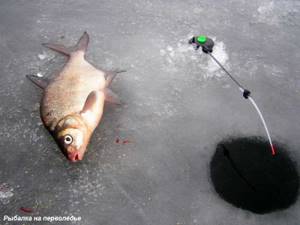
Safety precautions
When fishing, unpleasant incidents often happen that cannot be justified by any catch. You should go fishing when the ice thickness is 7-10 cm and wear comfortable clothes. You need to have an awl or a knife or an ice pick tied to you.
It is recommended to go out on the first ice in a group of 2-3 people. They can provide insurance in unforeseen situations. You need to move quietly so as not to scare the fish. In the absence of snow, it is advisable to cover young ice with a cloth. The fish tries to hide in places with darker ice.
If the temperature rises when the thickness is 5-6 cm, you should not go out on the ice. You need to wait until its thickness reaches 7-10 cm. For a group of fishermen, the minimum thickness is 14 cm. Vehicles are allowed to travel onto the ice cover if its thickness is at least 25 cm. To maintain safety on the first ice, you need to know and follow the following simple rules:
- do not walk alone on young ice;
- when walking, try not to lift your feet from the surface of the cover;
- the clothes you wear when going fishing should be loose;
- Check the condition of the ice regularly with a pick;
- have rescue equipment with you;
- when ice cracks appear, immediately lie down on your stomach to crawl to safe areas of the reservoir;
- do not drink alcohol;
- Do not panic if you get into the water.
Following these rules will protect you from icy swimming.
Gear for fishing on the first ice and expected catch
Fishing gear should be light in weight. These can be different spinners or a balancer. The best lure is homemade. Over time it is brought to perfection. At shallow depths, a vertical spinner works well.
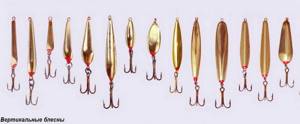
To catch small fish, jig tackle and a fishing rod with a nod are used. It is also used when fishing for perch. First ice is the time to use various fishing gear.
Float rod
Ice fishing requires the use of several fishing rods. Not the last place among them is the float. It consists of equipment and a filly, has a compact size, and can even fit in your pocket. The gear is used for catching bream, roach, silver bream, gudgeon, perch, and ruffe. Fishing on the first ice uses natural bait and groundbait.
Groundbait in the form of bloodworms is very common. You need to put 1-3 larvae on the hook and lower it into the water. The bite is determined by the float that floats in the hole. A hook is made with the hand.
A fishing line with a thickness of 0.08-0.12 mm is wound onto a reel located on the fishing rod. Float fishing on the first ice can bring prey in the form of large fish.
Tackle with jig and nod
In winter, jigs and nods are often used. This fishing rod looks like a float rod. The only difference is the nod, which is used instead of a float. The nod is not just a bite signal, it gives the jig additional movement. The fishing rod is used on the first ice when fishing for perch, bleak, roach, silver bream, and white bream.
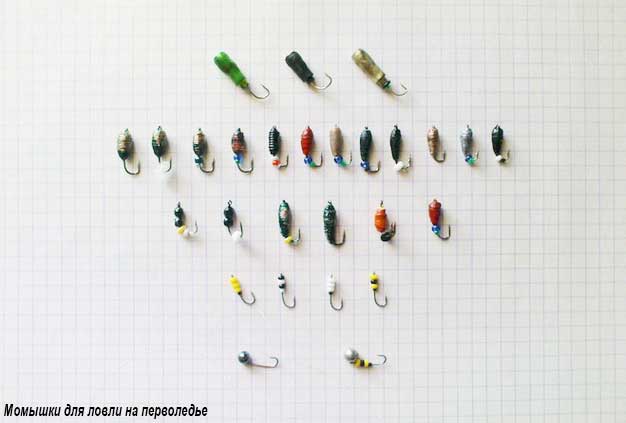
The jig can be attached or unattached. The result of fishing is influenced only by the play of the jig.
Sheer trolling rod
Fishing on the first ice is also done using vertical lures. For this, a balancer or a spinner is used. The fishing rod has a longer rod and thicker line. The tackle is intended for catching trout, pike perch, perch, pike, and bream. The bait is spoons or a balancer. A large spoon can be used to catch a large predator.
When flashing, sharp swings of the hand are made. As a result, the spoon takes off from the depths and falls again. The moment of the bite is determined by the behavior of the nod. It is advisable to equip the fishing rod with a reel so that at the right time you can give the fishing line or part of it to the predator.
Winter girders
The predator is also caught using girders in winter. Pike, perch, pike perch, burbot, trout and other fish species bite on them. All available types of vents have the same operating principle. A fishing line with a thickness of 0.2-0.4 mm is wound onto the reel. A hook and sinker is attached to the end of the line. The tackle is installed on the hole, the live bait on the hook is lowered into the water. A flag serves as a bite signal. The fisherman can only wait and fish out the catch from the ice hole. You can equip the vent with your own hands and for free.
Choosing a fishing spot
There is an opinion among fishermen that fishing on the first ice will bring a rich catch under any conditions. Yes, this opinion is very true, however, if the water surface is completely frozen by ice. In such cases, if there is no bite in the coastal part, you can safely move closer to the middle of the reservoir and fish the riverbeds and bays. The difficulty in choosing a location lies in the fact that most reservoirs are fed by springs and the ice covers them unevenly. Initially, ice forms in areas of the reservoir where the wind blows least and in creeks. And in such cases, the fish leave such places, because under the ice the water temperature is noticeably lower. But when an ice crust envelops the coastal part, that’s where you need to look for fish. Everyone knows that most peaceful fish are constantly located near the shore, and during freeze-up, those species that were found throughout the reservoir roll down to the shore in search of food.
On rivers, fish begin to rapidly approach the shore as soon as ice edges appear. Only now, in winter, if the fish feels any danger while feeding near the shore, then it immediately returns to the riverbed. It becomes even more difficult to find large fish; they are often located on the border of the current and calm water. Large fish swim to the shore in search of food at dusk and early morning. It is worth paying attention to places with matte ice, where your shadow will not be very visible and will not scare away cautious fish. If you are focused on catching large fish, then you need to approach the fishing spot as quietly as possible. When winter fishing on the current, a large proportion of bites occur at the moments of determining the depth, when the bait is not yet on the bottom. Most likely, the current moves the jig from side to side, which attracts fish.
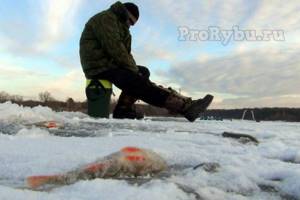
When the first ice forms on a reservoir, many underwater inhabitants begin to stagnate at the boundaries of light ice and dark ice (dull and shiny). If the ice is matte along the entire coastline, then you should pay attention to its border with the water. Don’t forget about ice safety, especially if you’re fishing near open water. Pay special attention to dark ice, it does not allow light to pass through and there can be a lot of fish standing there, both predatory and peaceful.
Where does the fish bite better on the first ice?
Fish bite on the first ice in any body of water. This could be a lake, pond or river. As the ice thickness increases, the perch sinks to the rough surface. It lives on the borders of ice and clean water, in algae. Perch hunts in large schools in the morning and evening. You can catch up to 10 pieces from one hole. The bait is small fish.
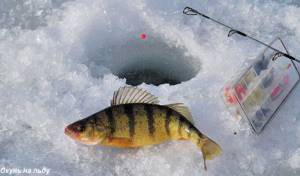
Burbot on the first ice is caught after the ice reaches a thickness of 10 cm. This must be done near the shore using a spoon. The most active bite begins in the evening. The bait is caught in the same reservoir.
River with current
Fishing before the first ice is more dangerous, because it is not uniform. With a strong current, eddies are formed and the ice becomes thinner. It's hard to notice with the eye. If you fail, you can easily fall under the ice. For fishing use:
- jigs with a nod;
- balancers;
- vertical spinners;
- float rods with a nod;
- microjig;
- winter girders.
These gears work effectively on rivers with currents. When working with baits, you need to have different types. The peculiarities of ice fishing on the river are such that successful fishing will leave pleasant memories in your memory.
Pond with standing water
In the pond, fish are observed to be dispersed throughout the water area of the reservoir. It can be caught in the reeds, close to the shore, at great depths. In the reservoirs of lakes and ponds, fish are caught all winter. But the most active bite occurs on the first cover. Jigs, hooks and sinkers need to be light, because there is no current. The most successful places are in bays and oxbow lakes. After complete icing, the fish leave these places for the rivers, where they can be caught with a jig; fishing can also be done with other gear.
Winter jig fishing
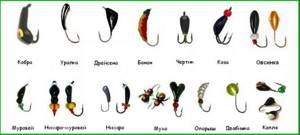
Mormyshka is an excellent bait. It is usually used in two forms: without an attachment or with an attachment on a bloodworm hook. The bloodworm bait is useful in catching perch in winter, because the fish may not rush to the jig without the bait.
At the same time, the external characteristics of the jig (shape, color) do not play a primary role, but it is very important to choose a jig with the correct weight and a comfortable size. It is also necessary to evaluate and check the hook - it is good if it is sharp and of medium size.
Using a jig with an attachment, you just need to take a couple of bloodworms, this number is enough to catch perch. It’s also great to feed the hole immediately before fishing, especially if the hole is not deep. Tactics and movement play an important role in fishing with a jig.
Often, perch bite in good numbers only thanks to the tempting game of the jig. We remember the pauses during the moments of playing with a jig, 15-20 seconds, and at this moment the main bites of the perch may occur. And if you lower it to the bottom and play, forming a cloudy cloud, the perch may decide that there are small fish or bugs in this ball, and a predator will start talking in it.
Catching perch on the first ice with a jig is perfect for anglers who are just starting out in this hobby.
